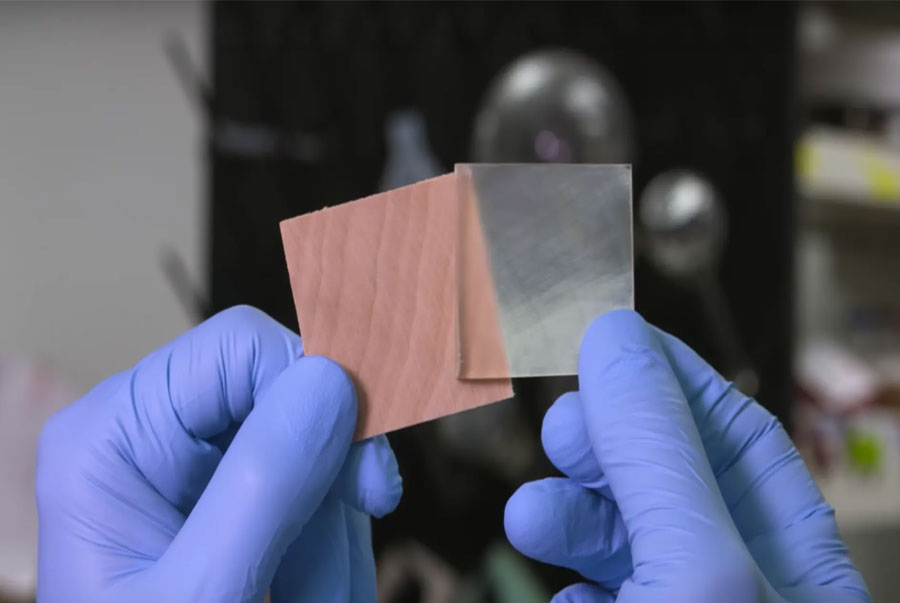Hi readers! don’t be surprised just visit the link below!
See-Through Wood Is Stronger Than Plastic and Tougher Than Glass | Scientific American
Transparent wood material is being exploited for smartphone screens, insulated windows, and more. Amazing, isn’t it? This is an article published in Scientific American for which they gave credit to USDA forest services.
The article explains the story of a German botanist who wished some thirty years ago that he wants to see the inner working of wood without dissecting it. The dream of this botanist (Siegfried Fink) came true when he bleached away all the pigments in plant cells and managed to create transparent wood.
Transparent wood is a new composite material that is made by treating and compressing wood strips to make it transparent. The process involves bleaching out the brown chromophores in the lignin of the wood using hydrogen peroxide, while leaving the lignin intact . The wood is then infused with a tough transparent epoxy designed for marine use, which fills in the spaces and pores in the wood and then hardens. It has the same strength as lumber while being far lighter. It is strong and as clear as glass with better insulating prosperities and potential application in the construction sector. Some researchers are exploring the possibility of using transparent wood as a replacement for steel in the construction sector.
Transparent wood composites are novel materials with up to 90% transparency. Some have better mechanical properties than wood itself. For example, these materials are significantly more biodegradable than glass and plastic and is also shatterproof making it suitable for applications in cell phone screens.
Transparent wood technique was first published in1992 in a niche wood technology journal and remained the last word on see-through wood for more than a decade, until a researcher named Lars Berglund stumbled across it.
Berglund was inspired by Fink’s discovery, but not for botanical reasons. Berglund: the materials scientist, specialized in polymer composites was interested in creating a more robust alternative to transparent plastic. And he wasn’t the only one interested, the University of Maryland was also busy on a related goal: harnessing the strength of wood for nontraditional purposes.
After years of experiments, the research of these groups is starting to bear fruit and could soon be used in super-strong screens for smartphones; in soft, glowing light fixtures; and even as structural features, such as color-changing windows.
“I truly believe this material has a promising future,” says Qi Liang Fu, a wood nanotechnologist at Nanjing Forestry University in China who worked in Berglund’s lab as a graduate student”.
Wood is made up of countless little vertical channels, like a tight bundle of straws bound together with glue. These tube-shaped cells transport water and nutrients throughout a tree and when the tree is harvested and the moisture evaporates, pockets of air are left behind. To create see-through wood, scientists first need to modify or get rid of the glue, called lignin: that holds the cell bundles together and provides trunks and branches with most of their earthy brown shade. After bleaching lignin’s color away or removing it, a milky-white skeleton of hollow cells remains.
This skeleton is still opaque, because the cell walls bend light to a different degree than the air in the cell pockets does: a value called a refractive index. Filling the air pockets with a substance like epoxy resin that bends light to a similar degree to the cell walls renders the wood transparent. The end material is thin (less than a millimeter to a centimeter), but the cells create a sturdy honeycomb structure, and the tiny wood fibers are stronger than the best carbon fibers, says materials scientist Liang Bing Hu, who leads the research group working on transparent wood at the University of Maryland in College Park. With the resin added, transparent wood outperforms plastic and glass. Upon testing, it appeared three times stronger than transparent plastics like Plexiglass and about 10 times tougher than glass.
The slim profile and strength of the material means it could be a great alternative to products made from thin, easily shattered cuts of plastic or glass, such as display screens. The French company Woo doo, for example, uses a similar lignin-removing process in its wood screens, but leaves a bit of lignin to create an unusual color. The company is tailoring its recyclable, touch-sensitive digital displays for products including car dashboards and advertising billboards.
Did you see, dear readers, what is happening around you? Amazing things you never know about.
Keep reading about the wonders of tsunami technology for which you will never be tired off.
See you next week. Take care, bye.





